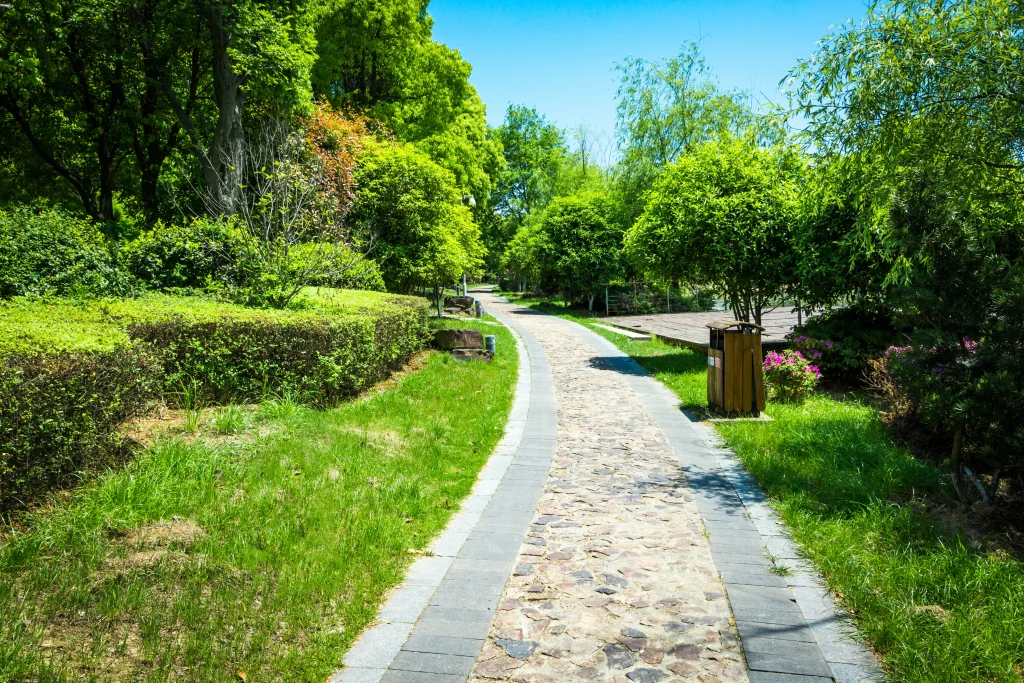When is the best time to dethatch your lawn? The best time to dethatch your lawn for Denver residents with cool-season grasses is early fall (mid-September to early October) or early spring (late April to early May) to provide optimal conditions for lawn recovery after dethatching.
Dethatching – the process of removing the layer of dead grass, roots, and debris that accumulates between your living grass and soil surface – is a crucial lawn maintenance task that’s often overlooked by homeowners in the Mile High City.
But here’s the challenge: timing your dethatching wrong in Denver’s unique high-altitude climate can do more harm than good.
In this comprehensive guide, we’ll walk you through exactly when to dethatch your lawn in Denver’s challenging climate conditions. We’ll examine seasonal timing considerations, provide grass-specific recommendations, and share professional techniques to ensure your lawn thrives after dethatching.
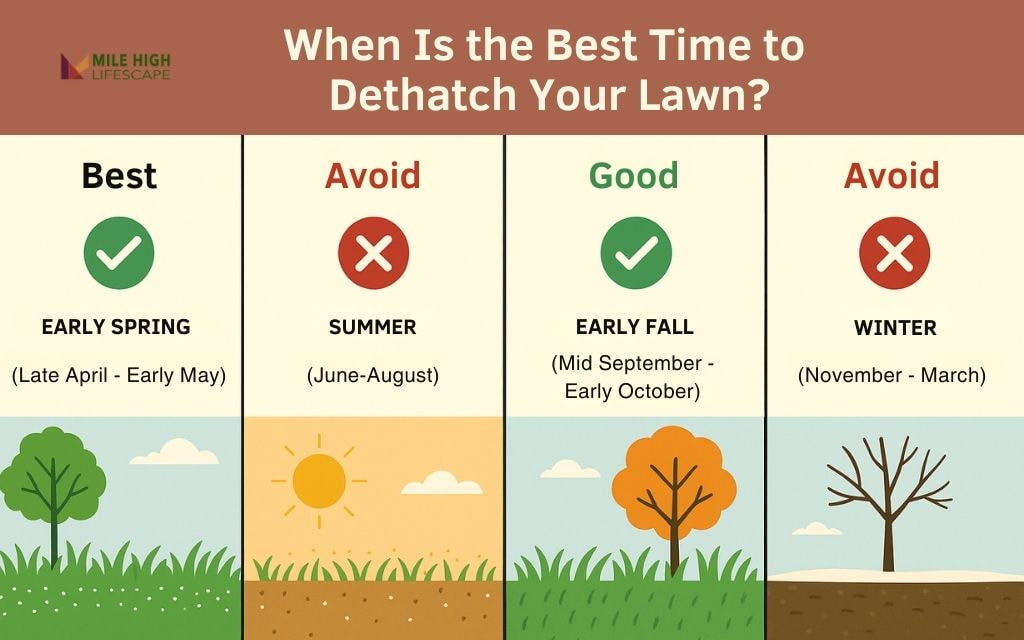
What Is Lawn Thatch?
Thatch is a layer of organic material – primarily dead grass stems, roots, and debris – that accumulates between your soil surface and the green grass blades you see. While a thin layer (under ½ inch) can be beneficial by providing insulation, anything thicker becomes problematic.
Denver lawns are particularly susceptible to thatch buildup due to several factors:
- Low humidity: Our dry climate slows natural decomposition of organic matter
- Clay-heavy soils: Denver’s clay soils limit microbial activity that breaks down thatch
- Shallow watering habits: Many homeowners water frequently but not deeply, encouraging shallow root systems
- High altitude conditions: Increased UV exposure and temperature extremes stress grass and slow decomposition
- Short growing season: Limited time for natural thatch breakdown during active growth periods
Controlling thatch thickness improves:
- Water penetration into Colorado’s often-compacted soils
- Root development and drought resistance
- Nutrient absorption efficiency
- Disease resistance by reducing fungal pathogen habitat
When Is the Best Time to Dethatch Your Lawn in Denver?
Timing your dethatching efforts with Denver’s climate patterns ensures your lawn recovers quickly without additional stress.
| Season | Suitability | Explanation |
| Early Spring (Late April – Early May) | Best | Grass enters active growth phase and can recover quickly; allows time to establish before summer heat |
| Summer (June – August) | Avoid | High temperatures and drought conditions add stress; grass recovery is compromised |
| Early Fall (Mid September – Early October) | Good | Cool temperatures and adequate moisture create perfect recovery conditions; allows re-establishment before winter |
| Winter (November – March) | Avoid | Grass dormancy period; dethatching causes damage with minimal recovery potential |
What Grass Types in Denver Need Dethatching and How Often?
Denver’s lawns primarily feature cool-season grasses, each with different thatch development tendencies:
- Kentucky bluegrass, the most common residential turf grass in Denver, produces aggressive rhizomes that contribute to thatch buildup. These lawns typically require dethatching every 2-3 years, or whenever thatch exceeds ½ inch thickness.
- Tall fescue develops minimal thatch due to bunch-type growth patterns without rhizomes or stolons. Only dethatch tall fescue lawns when visible thatch accumulates – often at 4-5 year intervals or longer.
- Perennial ryegrass rarely develops problematic thatch and seldom requires mechanical removal.
To check thatch thickness, extract a small wedge of turf (3-4 inches deep) with a soil probe or spade. Measure the brown layer between green grass and soil – if it exceeds ½ inch, schedule dethatching during the next optimal window.
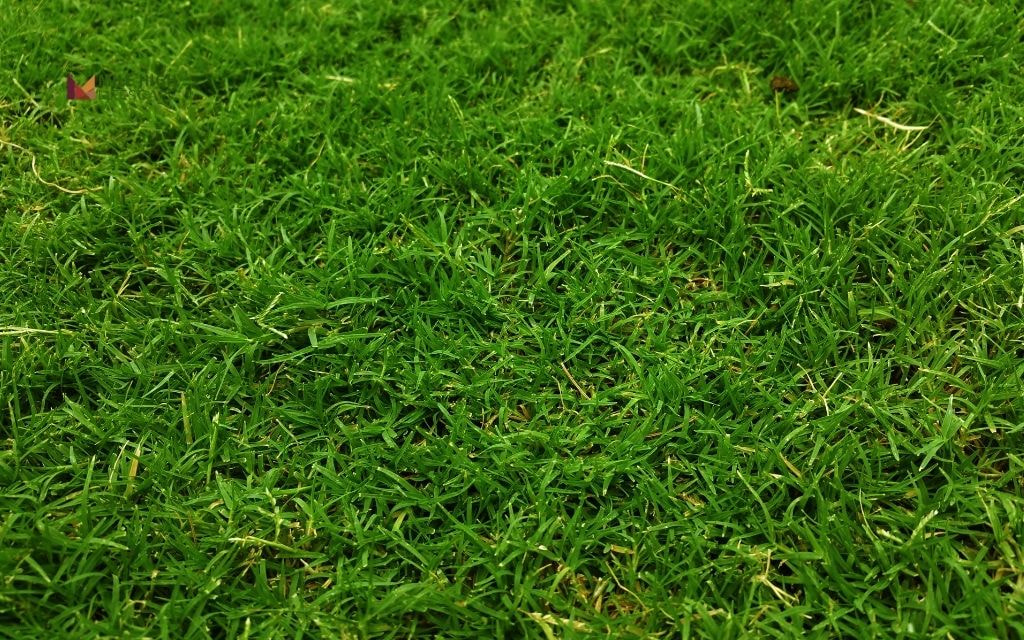
Signs It’s Time to Dethatch Your Denver Lawn
Your lawn communicates when thatch restricts its growth. Watch for these indicators:
- Spongy sensation when walking across the lawn
- Water pooling or running off rather than absorbing into soil
- Persistent brown or yellow patches despite regular fertilization
- Increased disease susceptibility, particularly during humid periods
- Visible thatch layer exceeding ½ inch thickness
- Shallow root development when pulling grass blades
- Declining response to fertilizer applications
- Poor tolerance to Denver’s summer heat stress
How to Dethatch a Lawn in Denver (Step-by-Step)
Once you’ve determined that dethatching is necessary and you’ve chosen the optimal time (early fall or early spring), follow these steps for the best results:
- Prepare your lawn by mowing it to a height of 1.5 to 2 inches – shorter than the typical 2.5 to 3-inch recommendation for lawns. This shorter height makes the dethatching process more effective by allowing better access to the thatch layer.
- Water your lawn lightly 2-3 days before dethatching. At Denver’s altitude, dethatching in overly dry conditions can stress grass, while working on saturated soil can damage your lawn’s structure. Aim for moist but not soggy soil.
- Choose the right tool based on your lawn size and thatch thickness: Small lawns/light thatch: Dethatching rake (manual rake with sharp tines); Medium lawns/moderate thatch: Power rake (machine that uses flexible tines to pull up thatch); Large lawns/heavy thatch: Vertical mower (machine with vertical blades that cut through thatch)
- Adjust equipment depth properly. Set the tines or blades to penetrate just to the top of the soil surface – deep enough to lift thatch but not so deep that you damage the grass crowns or tear up soil.
- Make two passes over your lawn in perpendicular directions (north-south, then east-west). This cross-pattern ensures you’ve thoroughly lifted thatch from all areas.
- Rake up and remove all debris immediately after dethatching. Don’t leave the removed thatch on your lawn, as it can smother the grass and reintroduce the problems you’re trying to solve.
- Consider following with core aeration, especially beneficial for clay soils. The combination of dethatching and aerating creates ideal conditions for air, water, and nutrients to reach grass roots.
- Apply a starter fertilizer with a balanced NPK ratio to help your lawn recover. Alkaline soils often need specific nutrient blends, so choose a product formulated for high-altitude lawns.
- Water thoroughly after dethatching to help the lawn recover from stress and to settle soil that may have been disturbed during the process.
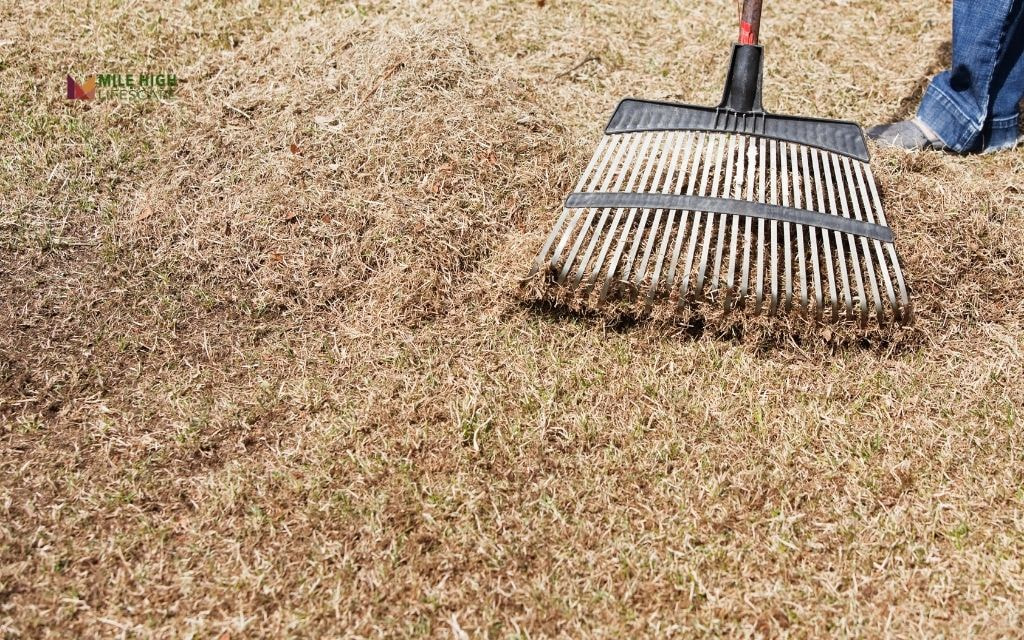
After Dethatching: How to Help Your Lawn Recover
Proper post-dethatching care is critical for Denver lawns, especially given our challenging growing conditions. Follow these recovery steps to ensure your lawn bounces back quickly and healthier than before:
Watering Strategy
- Water deeply immediately after dethatching
- For the next 7-10 days, water more frequently than usual (but still deeply)
- Aim to keep the soil consistently moist but never soggy
- Consider morning watering to reduce evaporation in Denver’s dry air
- Adjust for rainfall and temperature (more water during hot periods)
Fertilization Plan
- Apply a balanced, slow-release fertilizer (look for products designed for Colorado’s alkaline soils)
- For spring dethatching, use a fertilizer with more nitrogen to encourage growth
- For fall dethatching, use a higher phosphorus and potassium blend to promote root development
- Consider adding iron supplements to counteract Colorado’s naturally iron-deficient soils
Overseeding Recommendation
- Post-dethatching is an ideal time to overseed thin or bare areas
- Use a blend of Kentucky bluegrass, perennial ryegrass, and turf-type tall fescue
- Apply seed at the manufacturer’s recommended rate for overseeding
- Consider a light top dressing of compost to improve seed-to-soil contact
- Keep newly seeded areas consistently moist until germination
Mowing Guidelines
- Avoid mowing for 5-7 days after dethatching to allow recovery
- When you resume mowing, maintain a height of 2.5-3 inches (taller than before dethatching)
- Ensure mower blades are sharp to make clean cuts that heal quickly
- Follow the “one-third rule” – never remove more than one-third of grass height in a single mowing
- Consider mulch mowing to return nutrients to the soil
Common Mistakes to Avoid When Dethatching
Even with proper timing, dethatching mistakes can compromise your lawn’s health:
- Dethatching during drought conditions forces grass to recover without adequate moisture, particularly challenging in Denver’s arid climate.
- Using excessive pressure with power equipment removes living tissue along with thatch, extending recovery time unnecessarily.
- Dethatching multiple times per season overwhelms the lawn’s ability to recover.
- Neglecting post-dethatching care wastes the opportunity to establish stronger root systems.
- Dethatching warm-season grasses (like buffalograss) during their dormant periods damages crown tissue.
- Skipping soil testing before dethatching misses opportunities to address underlying soil issues that contribute to thatch development.
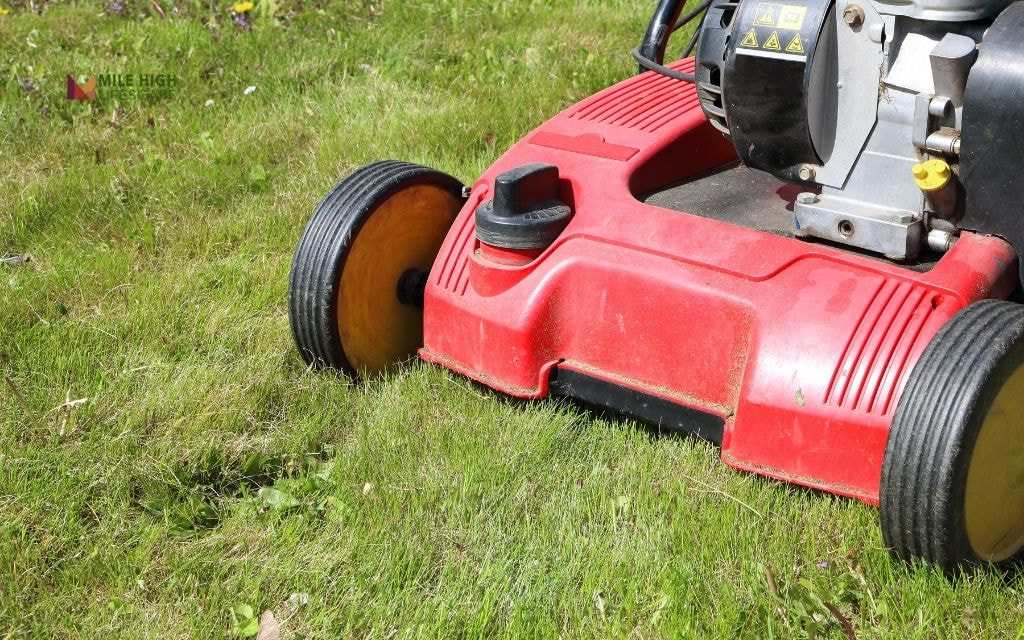
Conclusion
Strategic dethatching during early fall or spring gives Denver lawns the best chance to recover and thrive. By understanding your grass type, measuring thatch thickness, and following proper techniques, you’ll transform a struggling lawn into resilient turf capable of withstanding Colorado’s challenging conditions.
Remember that dethatching represents just one component of comprehensive lawn care. For professional evaluation, dethatching services, or guidance specific to your property, contact Mile High Lifescape. Our experts understand Denver’s unique growing conditions and provide customized solutions for your lawn’s specific needs.
Frequently asked questions (FAQs)
What month should I dethatch my lawn in Denver?
Mid-September to early October provides optimal conditions for dethatching in Denver. The combination of warm soil temperatures and cooler air temperatures creates ideal recovery conditions without the stress of summer heat. For spring dethatching, late April to early May works best once soil temperatures consistently reach 55°F.
Should I cut my grass before dethatching?
Yes, mow your lawn to approximately 1.5-2 inches before dethatching. This shorter height exposes more thatch for removal and reduces stress on grass blades during the dethatching process. Avoid cutting too short, which can weaken the grass and limit its recovery capability.
How do you tell if you need dethatching?
Use a trowel or spade to remove a wedge-shaped layer of grass and soil about 3 inches deep. Examine the brown layer between green grass and soil surface – if it exceeds ½ inch thickness, dethatching benefits your lawn. Additional indicators include spongy texture when walking, water pooling instead of absorbing, and declining response to fertilization.
How do I prepare my lawn for dethatching?
To prepare your lawn for dethatching, water it lightly 2-3 days before the procedure to ensure soil moisture without saturation. Mark sprinkler heads, shallow irrigation lines, and other obstacles to prevent equipment damage. Mow to a shorter height (1.5-2 inches) and ensure you have appropriate equipment based on your lawn size and thatch severity.
Will grass grow back after dethatching?
Yes, healthy grass recovers from proper dethatching. The process removes dead organic material while leaving crown tissue and roots intact to regenerate. Recovery speed depends on grass type, season, and post-dethatching care. Kentucky bluegrass typically recovers within 2-3 weeks when dethatched during optimal seasons and with proper follow-up maintenance.
